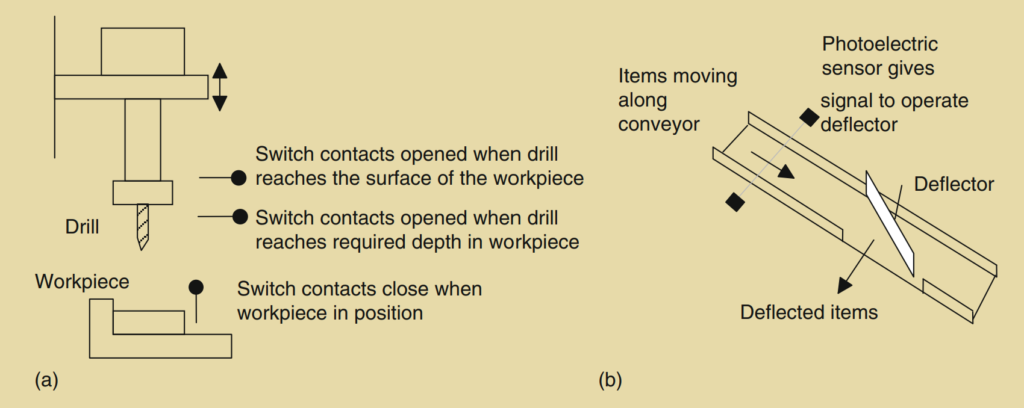This article is about Controllers. A control system is responsible for handling various tasks, which may include controlling a sequence of events, maintaining a variable at a constant value, or following a prescribed change. Let’s consider a couple of examples to illustrate these tasks:
- Automatic Drilling Machine Control System: The control system for an automatic drilling machine is designed to perform a sequence of actions. It may start lowering the drill when the workpiece is in position, initiate drilling when the drill reaches the workpiece, stop drilling when the required depth is achieved, retract the drill, and then switch off and wait for the next workpiece to repeat the operation.
- Conveyor Belt Control System: Another example is a control system used to manage the number of items moving along a conveyor belt and directing them into a packing case. The control system monitors the inputs from switches or sensors that detect the presence of items on the belt. It then controls the movement of motors or actuators to guide the items into the packing case.
The controller in a control system can take different forms depending on the application:
- Electrical Circuits: In the case of the automatic drilling machine, electrical circuits can be used as controllers. Closing or opening switches can activate relays, which, in turn, control motors or valves. For example, closing a switch might activate a relay that switches on the motor to rotate the drill, while another switch can activate a relay to control a pneumatic or hydraulic valve for positioning the workpiece.
- Wiring and Circuits: The control actions and rules in traditional control systems are determined by the wiring configuration. When changes are required in the control rules, the wiring needs to be modified accordingly.
It’s important to note that these examples represent traditional control systems, and with advancements in technology, modern control systems often involve digital controllers, programmable logic controllers (PLCs), or microcontrollers, which provide more flexibility and ease of modification without requiring physical wiring changes.


Microprocessor-Controlled Systems
Microprocessor-controlled systems offer significant advantages over hardwired control circuits. Instead of designing specific circuits for each control situation, a microprocessor-based system can use a program to instruct the microprocessor on how to react to input signals and provide the required outputs. This flexibility allows the same system to be used for different control scenarios by simply changing the instructions in the program.
A microprocessor-based control system can be programmed with a set of instructions that define the response to various input signals. For example:
If switch A closes
Output to motor circuit
If switch B closes
Output to valve circuit
By modifying these instructions in the program, the microprocessor system can be utilized to control a wide range of situations without the need for physical reconfiguration.
As an example, consider a modern domestic washing machine that employs a microprocessor-based system. The microprocessor receives inputs from various sources such as dials for selecting the wash cycle, a switch to detect the closed machine door, a temperature sensor for water temperature, and a switch to determine the water level. Based on these inputs, the microprocessor is programmed to generate outputs that activate the drum motor and control its speed, open or close hot and cold water valves, activate the drain pump, regulate the water heater, and manage the door lock to prevent opening until the washing cycle is completed.
The use of a microprocessor allows for more flexibility, programmability, and adaptability in control systems, making it possible to handle diverse control scenarios with a single system by reprogramming its instructions.
Programmable Logic Controller
A Programmable Logic Controller (PLC) is a specialized device used for controlling processes and machines. It is equipped with programmable memory that stores instructions for logic, timing, arithmetic, and sequencing operations. PLCs are based on microcontroller processors, making them efficient in executing control tasks.
PLCs are primarily focused on implementing logic and switching operations. They are programmed to respond to specific conditions or events by carrying out control actions. For example, if a certain input condition is met, the PLC can activate a corresponding output device such as a motor or a valve. Input devices (e.g., sensors) and output devices (e.g., motors, valves) are connected to the PLC, which monitors these inputs and outputs based on the programmed instructions.
One of the significant advantages of PLCs is their versatility. The same PLC controller can be used in various control systems by simply inputting a different set of instructions. This flexibility eliminates the need for rewiring, making the system cost-effective and adaptable to different control scenarios.
PLCs are designed specifically for control tasks in industrial environments. They are built to withstand vibrations, temperature variations, humidity, and noise commonly found in industrial settings. PLCs provide built-in interfaces for connecting inputs and outputs, simplifying the integration process.
PLCs have their own programming language, which is typically easy to understand and focuses on logic and switching operations. They can be easily programmed by engineers and technicians with computing programming knowledge.
The first PLC was developed in 1969, and since then, they have become widely used in industrial automation. PLCs range from small, self-contained units with a limited number of digital inputs/outputs to modular systems capable of handling large numbers of inputs/outputs, both digital and analog. Advanced PLCs can also perform proportional-integral-derivative (PID) control modes, allowing for precise control in various applications.
